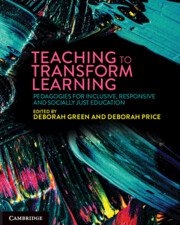Book contents
- Teaching to Transform Learning
- Acknowledgement of Country
- Teaching to Transform Learning
- Copyright page
- Contents
- Contributors
- Acknowledgements
- Introduction Understanding the learner to inform educators’ implementation of pedagogical approaches to transform learning
- Part 1 Pedagogies for all
- Part 2 Engaging pedagogies: making the curriculum come alive for all learners
- 8 Redesigning pedagogy for transformation: creative body-based learning
- 9 Building transformative classrooms through visual and creative body-based learning design
- 10 Co-constructed early childhood pedagogies
- 11 Strengths-based, learner-centred pedagogies: the voice of learners in co-creation and co-design
- 12 Pedagogy informed by community expertise
- 13 Nature-based approaches enhancing experiential learning
- 14 Beyond the four walls
- Part 3 Empowering pedagogies: 21st-century skill development and 22nd-century futures thinking
- Index
- References
12 - Pedagogy informed by community expertise
from Part 2 - Engaging pedagogies: making the curriculum come alive for all learners
Published online by Cambridge University Press: 25 October 2024
- Teaching to Transform Learning
- Acknowledgement of Country
- Teaching to Transform Learning
- Copyright page
- Contents
- Contributors
- Acknowledgements
- Introduction Understanding the learner to inform educators’ implementation of pedagogical approaches to transform learning
- Part 1 Pedagogies for all
- Part 2 Engaging pedagogies: making the curriculum come alive for all learners
- 8 Redesigning pedagogy for transformation: creative body-based learning
- 9 Building transformative classrooms through visual and creative body-based learning design
- 10 Co-constructed early childhood pedagogies
- 11 Strengths-based, learner-centred pedagogies: the voice of learners in co-creation and co-design
- 12 Pedagogy informed by community expertise
- 13 Nature-based approaches enhancing experiential learning
- 14 Beyond the four walls
- Part 3 Empowering pedagogies: 21st-century skill development and 22nd-century futures thinking
- Index
- References
Summary
In Australia, the educator landscape continues to be dominated by persons who are non-Indigenous, middle-class, speakers of English as their primary language and of European/Anglo cultural heritage (Daniels-Mayes 2016; Perso & Hayward 2015). When working with culturally minoritised learners, educators currently find themselves operating amid educational imperatives that are often complex and contradictory (Unsworth 2013). As foregrounded in chapters 3–5, cultural responsivity is a pedagogical approach that seeks to value, recognise and utilise the intelligence and cultural capacities that students already possess in the classroom (Morrison et al., 2019). This is a practice that requires educators to go beyond the limitations of simply being culturally aware, having cultural understanding or being culturally competent and instead seeks to tailor an educator’s practice according to learners’ unique place-based linguistic and cultural repertoires. In doing so, the eductor acknowledges through their practice that First Nations contexts are not all the same and that learners will often speak a range of differing home languages.
Keywords
- Type
- Chapter
- Information
- Teaching to Transform LearningPedagogies for Inclusive, Responsive and Socially Just Education, pp. 187 - 202Publisher: Cambridge University PressPrint publication year: 2024

